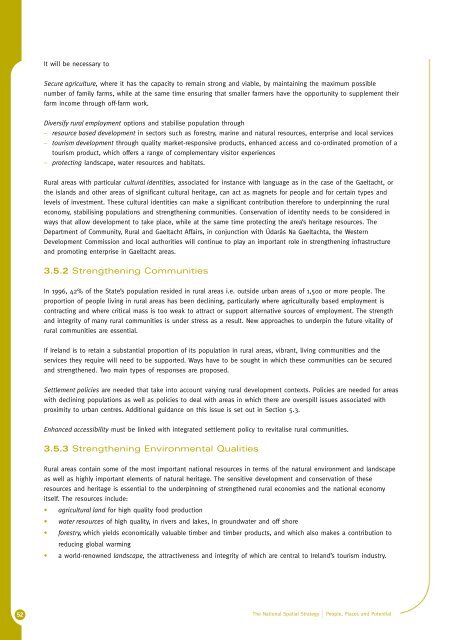National Spatial Strategy For Ireland 2002 - 2020 - Full ... - Kildare.ie
National Spatial Strategy For Ireland 2002 - 2020 - Full ... - Kildare.ie
National Spatial Strategy For Ireland 2002 - 2020 - Full ... - Kildare.ie
Create successful ePaper yourself
Turn your PDF publications into a flip-book with our unique Google optimized e-Paper software.
52<br />
It will be necessary to<br />
Secure agriculture, where it has the capacity to remain strong and viable, by maintaining the maximum possible<br />
number of family farms, while at the same time ensuring that smaller farmers have the opportunity to supplement their<br />
farm income through off-farm work.<br />
Diversify rural employment options and stabilise population through<br />
– resource based development in sectors such as forestry, marine and natural resources, enterprise and local services<br />
– tourism development through quality market-responsive products, enhanced access and co-ordinated promotion of a<br />
tourism product, which offers a range of complementary visitor exper<strong>ie</strong>nces<br />
– protecting landscape, water resources and habitats.<br />
Rural areas with particular cultural identit<strong>ie</strong>s, associated for instance with language as in the case of the Gaeltacht, or<br />
the islands and other areas of significant cultural heritage, can act as magnets for people and for certain types and<br />
levels of investment. These cultural identit<strong>ie</strong>s can make a significant contribution therefore to underpinning the rural<br />
economy, stabilising populations and strengthening communit<strong>ie</strong>s. Conservation of identity needs to be considered in<br />
ways that allow development to take place, while at the same time protecting the area’s heritage resources. The<br />
Department of Community, Rural and Gaeltacht Affairs, in conjunction with Údarás Na Gaeltachta, the Western<br />
Development Commission and local authorit<strong>ie</strong>s will continue to play an important role in strengthening infrastructure<br />
and promoting enterprise in Gaeltacht areas.<br />
3.5.2 Strengthening Communit<strong>ie</strong>s<br />
In 1996, 42% of the State’s population resided in rural areas i.e. outside urban areas of 1,500 or more people. The<br />
proportion of people living in rural areas has been declining, particularly where agriculturally based employment is<br />
contracting and where critical mass is too weak to attract or support alternative sources of employment. The strength<br />
and integrity of many rural communit<strong>ie</strong>s is under stress as a result. New approaches to underpin the future vitality of<br />
rural communit<strong>ie</strong>s are essential.<br />
If <strong>Ireland</strong> is to retain a substantial proportion of its population in rural areas, vibrant, living communit<strong>ie</strong>s and the<br />
services they require will need to be supported. Ways have to be sought in which these communit<strong>ie</strong>s can be secured<br />
and strengthened. Two main types of responses are proposed.<br />
Settlement polic<strong>ie</strong>s are needed that take into account varying rural development contexts. Polic<strong>ie</strong>s are needed for areas<br />
with declining populations as well as polic<strong>ie</strong>s to deal with areas in which there are overspill issues associated with<br />
proximity to urban centres. Additional guidance on this issue is set out in Section 5.3.<br />
Enhanced accessibility must be linked with integrated settlement policy to revitalise rural communit<strong>ie</strong>s.<br />
3.5.3 Strengthening Environmental Qualit<strong>ie</strong>s<br />
Rural areas contain some of the most important national resources in terms of the natural environment and landscape<br />
as well as highly important elements of natural heritage. The sensitive development and conservation of these<br />
resources and heritage is essential to the underpinning of strengthened rural econom<strong>ie</strong>s and the national economy<br />
itself. The resources include:<br />
• agricultural land for high quality food production<br />
• water resources of high quality, in rivers and lakes, in groundwater and off shore<br />
• forestry, which y<strong>ie</strong>lds economically valuable timber and timber products, and which also makes a contribution to<br />
reducing global warming<br />
• a world-renowned landscape, the attractiveness and integrity of which are central to <strong>Ireland</strong>’s tourism industry.<br />
The <strong>National</strong> <strong>Spatial</strong> <strong>Strategy</strong> | People, Places and Potential
















